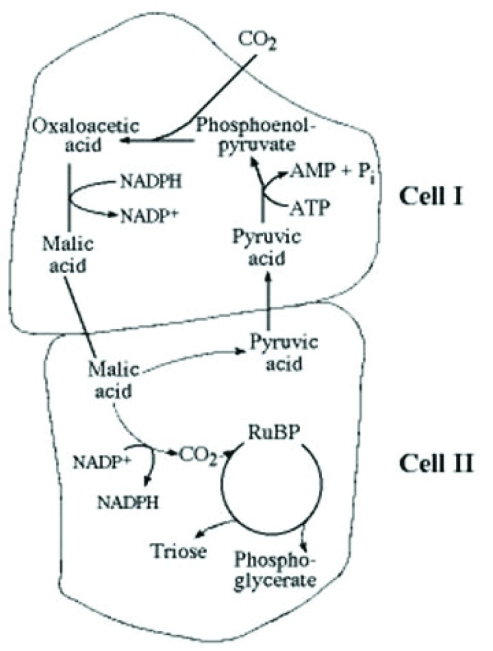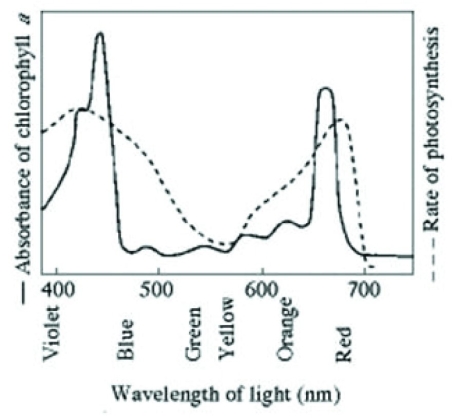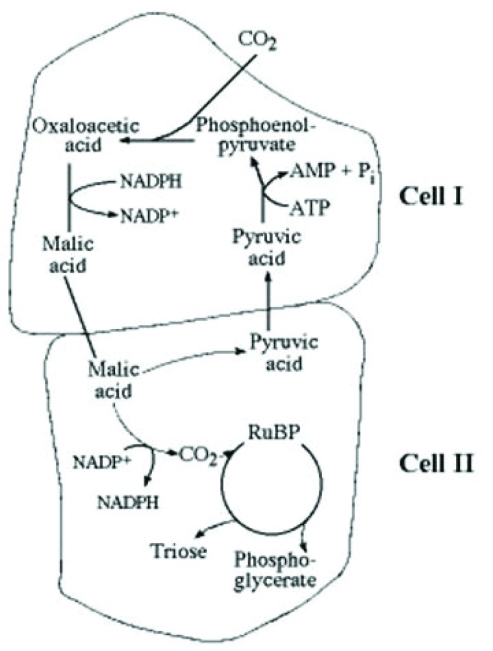A) glucose
B) sucrose
C) cellulose
D) starch
Correct Answer

verified
Correct Answer
verified
Multiple Choice
Which process is most directly driven by light energy?
A) creation of a pH gradient by pumping protons across the thylakoid membrane
B) reduction of NADP+ molecules
C) transfer of energy from pigment molecule to pigment molecule
D) ATP synthesis
Correct Answer

verified
Correct Answer
verified
Multiple Choice
A flask containing photosynthetic green algae and a control flask containing only water are exposed to a cycle of 12 hours of light and 12 hours of darkness. Which of the following statements best describes how the relative dissolved oxygen concentration in the flask with algae will compare to the control flask?
A) It will always be higher in the control.
B) It will always be lower in the control.
C) It will be lower in the control in the light, but the same in the dark.
D) It will be lower in the control in the light, but higher in the control in the dark.
Correct Answer

verified
Correct Answer
verified
Multiple Choice
Which of the following statements best describes the relationship between autotrophs and heterotrophs?
A) Autotrophs produce their organic molecules from CO2 and other inorganic molecules, whereas heterotrophs obtain their organic molecules from compounds produced by other organisms.
B) Heterotrophs produce their organic molecules from CO2 and other inorganic molecules, whereas autotrophs obtain their organic molecules from compounds produced by other organisms.
C) Both autotrophs and heterotrophs produce some of their organic molecules from CO2 and other inorganic molecules.
D) Heterotrophs are considered the producers of the biosphere, whereas autotrophs are consumers.
Correct Answer

verified
Correct Answer
verified
Multiple Choice
Which of the following processes is directly associated with photosystem I?
A) receiving electrons from the thylakoid membrane electron transport chain
B) generating molecular oxygen
C) extracting hydrogen electrons from the splitting of water
D) passing electrons to NADP+
Correct Answer

verified
Correct Answer
verified
Multiple Choice
 Which of the following statements best describes the accompanying figure?
Which of the following statements best describes the accompanying figure?
A) It represents a C4 photosynthetic system.
B) It represents an adaptation that maximizes photorespiration.
C) It represents a C3 photosynthetic system.
D) It represents a CAM photosynthetic system.
Correct Answer

verified
Correct Answer
verified
Multiple Choice
Which of the following statements best describes the conditions under which the Calvin cycle and cellular respiration occur in plants?
A) The Calvin cycle and cellular respiration both occur only in the light.
B) The Calvin cycle occurs only in the light, and cellular respiration occurs only in the dark.
C) The Calvin cycle occurs only in the dark, and cellular respiration occurs in both the dark and the light.
D) The Calvin cycle and cellular respiration both occur in the dark and the light.
Correct Answer

verified
Correct Answer
verified
Multiple Choice
 The accompanying figure shows the absorption spectrum for chlorophyll a and the action spectrum for photosynthesis. Which of the following statements best explains the low rate of photosynthesis at 550 nm?
The accompanying figure shows the absorption spectrum for chlorophyll a and the action spectrum for photosynthesis. Which of the following statements best explains the low rate of photosynthesis at 550 nm?
A) Green and yellow wavelengths inhibit the absorption of red and blue wavelengths.
B) Oxygen given off during photosynthesis interferes with the absorption of light.
C) Other photosynthetic pigments absorb light in addition to chlorophyll a.
D) Chlorophyll a does not absorb 550 nm light well.
Correct Answer

verified
Correct Answer
verified
Multiple Choice
In chloroplasts, the photosynthetic electron transport chain acidifies which of the following cellular compartments?
A) mitochondrial matrix
B) stroma
C) thylakoid space
D) cytosol
Correct Answer

verified
Correct Answer
verified
Multiple Choice
Which of the following molecules will accumulate if light reactions occur normally, but the Calvin Cycle is inhibited?
A) CO2 and glucose
B) H2O and O2
C) ADP, ![]() i, and NADP+
i, and NADP+
D) ATP and NADPH
Correct Answer

verified
Correct Answer
verified
Multiple Choice
Which of the following statements correctly describes a distinction between autotrophs and heterotrophs?
A) Only heterotrophs perform cellular respiration.
B) Only heterotrophs have mitochondria.
C) Only autotrophs can produce organic molecules from CO2 and other inorganic materials.
D) Only autotrophs require oxygen to produce organic molecules.
Correct Answer

verified
Correct Answer
verified
Multiple Choice
Lab students placed ten spinach leaf disks in each of three test tubes containing a baking soda solution and a control tube without baking soda. The volume of liquid in each tube and the temperature of the solutions were held constant. All tubes were placed an equal distance from a light source as indicated in the accompanying table. After 10 minutes, the amount of oxygen present in each sample was measured.
 Which tube is expected to contain the greatest quantity of oxygen?
Which tube is expected to contain the greatest quantity of oxygen?
A) Tube 1
B) Tube 2
C) Tube 3
D) Tube 4
Correct Answer

verified
Correct Answer
verified
Multiple Choice
In which cellular structure are the enzymes of the Calvin cycle localized?
A) stroma of the chloroplast
B) thylakoid membrane
C) interior of the thylakoid (thylakoid space)
D) outer membrane of the chloroplast
Correct Answer

verified
Correct Answer
verified
Multiple Choice
Carotenoids are often found in foods that are considered to have antioxidant properties in human nutrition. Which of the following statements best describes a related function they serve in plants?
A) They serve as accessory pigments to increase light absorption.
B) They protect against oxidative damage from excessive light energy.
C) They shield the sensitive chromosomes of the plant from harmful ultraviolet radiation.
D) They reflect orange light and enhance red light absorption by chlorophyll.
Correct Answer

verified
B
Correct Answer
verified
Multiple Choice
 In which cell of the accompanying figure would elevated oxygen concentrations have the greatest inhibitory effect on carbon fixation reactions?
In which cell of the accompanying figure would elevated oxygen concentrations have the greatest inhibitory effect on carbon fixation reactions?
A) cell I only
B) cell II only
C) neither cell I nor cell II
D) both cell I and cell II
Correct Answer

verified
B
Correct Answer
verified
Multiple Choice
Which of the following observations would be the best indicator that an organism lacks photosystem II?
A) It produces glucose in the light and dark.
B) It does not produce CO2 in the dark.
C) It does not produce O2 in the light.
D) It produces CO2 in the light.
Correct Answer

verified
Correct Answer
verified
Multiple Choice
Which of the following events are associated with chemiosmosis in chloroplasts?
A) The pH of the stroma increases and ATP is synthesized.
B) The pH of the thylakoid space increases and ATP is synthesized.
C) The pH of the cytosol outside the chloroplast decreases and ATP is synthesized.
D) The pH of the stroma decreases and ATP is hydrolyzed.
Correct Answer

verified
B
Correct Answer
verified
Multiple Choice
Which of the following processes occurs in the Calvin cycle?
A) reduction of NADPH
B) release of oxygen
C) reduction of CO2
D) production of ATP
Correct Answer

verified
Correct Answer
verified
Multiple Choice
Which of the following statements best explains the ability of CAM plants to synthesize sugars in the daytime while keeping their stomata closed to reduce water loss?
A) They fix CO2 into organic acids during the night.
B) They fix CO2 into sugars in the bundle-sheath cells.
C) They fix CO2 into pyruvate in the mesophyll cells.
D) They use photosystem I and photosystem II at night.
Correct Answer

verified
Correct Answer
verified
Multiple Choice
How is photosynthesis similar in C4 plants and CAM plants?
A) In both cases, only photosystem I is used.
B) Both types of plants make sugar without the Calvin cycle.
C) In both cases, rubisco is not used to fix carbon initially.
D) Both types of plants make most of their sugar in the dark.
Correct Answer

verified
Correct Answer
verified
Showing 1 - 20 of 64
Related Exams